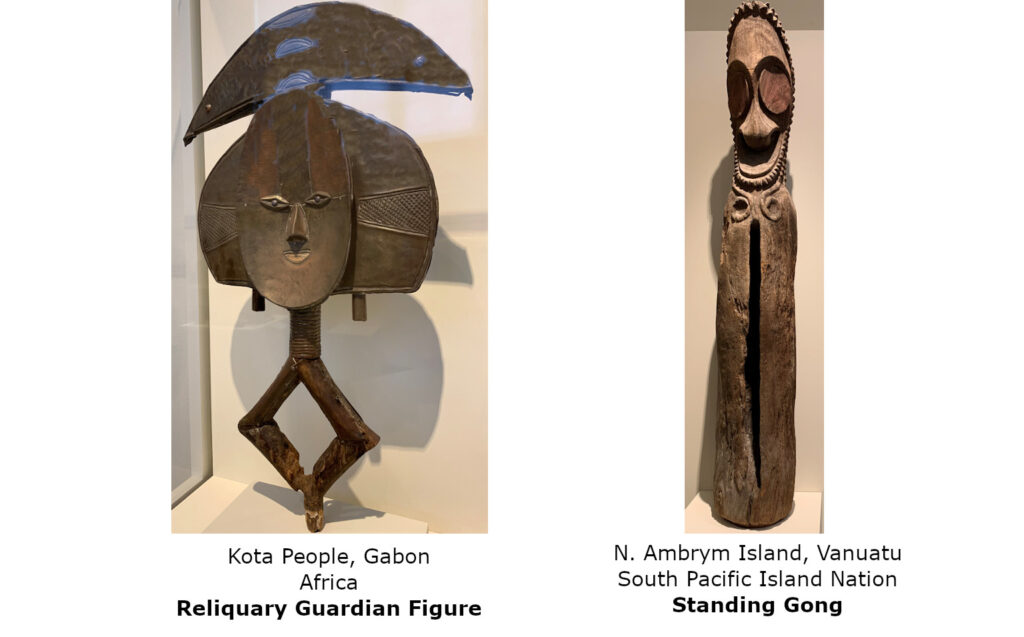In October, our thoughts turn to those spirits who may still roam among us. Other cultures didn’t try to keep these phantasms away, but encouraged them to stay with us, believing them to be ancestors who could help us from the beyond.
The Standing Gong from North Ambrym Island in Vanuatu, a South Pacific nation, shared a powerful purpose with the Koto People’s Reliquary Guardian Figure from Gabon, Africa. These two diverse cultures each found a profound way for ancestors to maintain a living presence among them.
Both societies used sacred geometry to symbolize the abstract spirit world their dear deceased inhabited. The Vanuatu figure’s two large rounded eyes and long spine-like line down the front resembled a heavenly nervous system pared down to its essentials. The Gabon figure’s skillfully balanced triangles, half-moons and oval shapes depicted their relative’s presence in a supernatural world. In both art traditions, the ritual figures kept their eyes open, suggesting spiritual awareness as they communicated with their earthly communities.
The specific methods used to converse with the honored dead differed. In Vanuatu, the statue, carved from a hollowed tree trunk, had a long opening that provided resonance to create sound. When pounded out with special rounded wooden pieces near the opening, the beats and pauses created deep, sonorous tones that literally spoke across miles in Morse code types of messages between villages. I love imagining how splendid and mysterious these deep reverberations must have been. With this super-power, the ancestors must have seemed to come alive.
The figure from Gabon contained the sacred and powerful bones and relics of a family member. When polished, its exterior, made from copper or brass, manifested a brilliant shiny quality. This light seemed to be a loved one’s caring spirit reaching out to ward off evil, thus protecting the village.The Reliquary Guardian’s geometric beauty, and that of many similar African sculptures, gifted powerful aesthetic revelations to nineteenth and twentieth century artists, inspiring Cubism and abstract art. Having learned visual secrets from native peoples, the modern art world came to hold deep regard for the power and magnificence of indigenous art forms such as the Standing Gong of Vanuatu and the Kota Peoples’ Reliquary Guardian Figure.

Right: African mask, enamel paint on wood
In this detail of Picasso’s 1907 “Demoiselles d’Avignon,” we see his direct inspiration from an African mask, the face broken into geometric abstraction. The features of both contain raw emotion. In Picasso’s “Guernica,” homage to a Spanish town that suffered intense fighting in the Spanish Civil War, the horse’s face is composed of geometric components. The spike in the open mouth seems to denote a scream of alarm or pain. This connotation of sound still seems to

call out to us to stop the horrors of war. This large painting, 25.5 feet wide and 11.5 feet high, is considered the world’s most powerful anti-war statement.
Through modern artists, perhaps the ancestors’ spirits have projected their presence onto contemporary western society, trying to help. They’ve given us the gift of seeing great power in abstract designs.
Kaethe Kauffman’s one-person exhibit, La Foresta, is at Castello Gallery 780 in Venice, Italy, April 19 to June 23, 2024. Castello Gallery 780 is affiliated with the Venice Biennale art fair.

